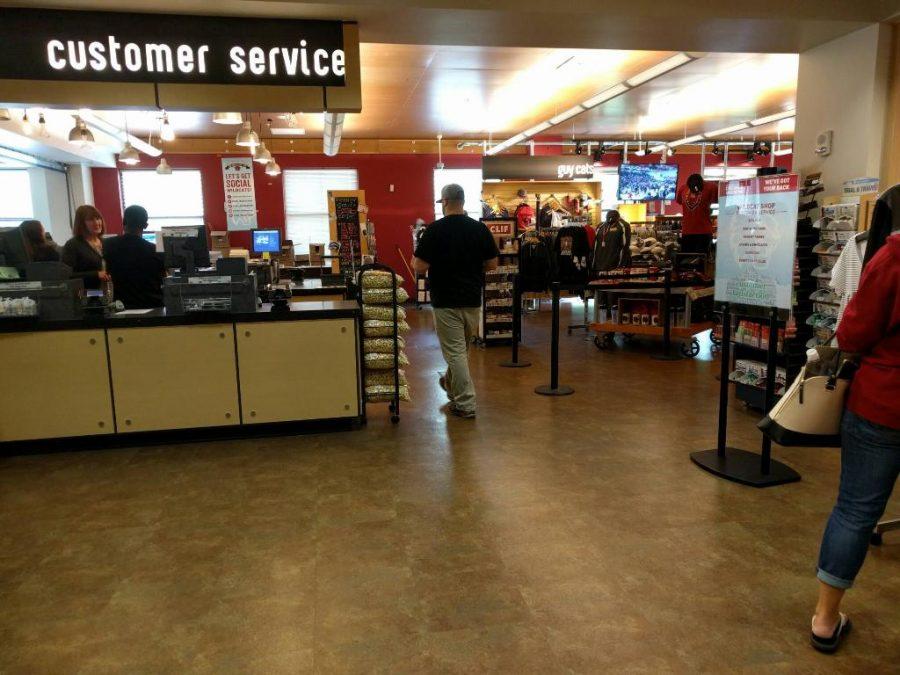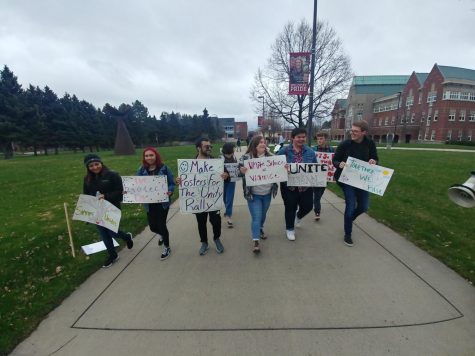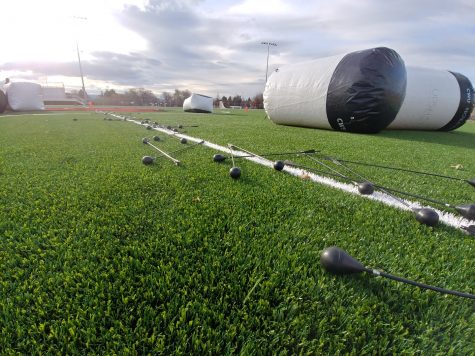CWU orientations take off with enrollment on the rise
Popular items, such as clothing, resulted in higher sales for the Wildcat Shop during orientations on campus
Campus introductions
With the new school year coming up, first year students have been touring the campus for the first time at Central Washington University.
The first year student orientation is broken up into four pillars which includes, “Campus Connections” where students make connections with staff, faculty and peers on campus. Another pillar includes “University Navigation” where students get to know their way around campus with the policies, procedures and resources.
“Academic Success” is another pillar in which students develop the skills, tools and habits to be a successful student academically, and “Responsible Citizenship” allows students the chance to explore and learn how to prepare their lives in a diverse, interconnected and evolving world on campus responsibly. Not only do the students go through this transition, but the parents do as well.
With the help of the student orientation staff–consisting of 19 orientation leaders (student mentors for 18 first year students each), three interns (who help manage everything at orientation), and 30 volunteers (helping with check in) who are all under the Assistant Director of First Year Students, John Mounsey, this makes the first year students and their parents feel welcome and at ease on campus.
According to Mounsey, the amount of students and parents attending orientation this year averages about 350 people within the August and September sessions. There’s an average of 200 people within the four sections of orientation.
This year has had over 1,900 people on average in attendance compared to last year, which averaged about 1,650 students. According to Mounsey, some of these students and parents can be nervous and overwhelmed at first, but at the end of the first session they can feel confident and ready to go for their first-year experience on campus.
Some of the students and parents that were attending these orientations said they had a lot of positive feedback on their first time experience on campus. Max Smith, an 18-year-old computer science major and first-year student from Redmond, Washington said that he feels “natural” about his experience at student orientation and got into the STEP Program.
Alex Simms, a first-year business major, expressed a similar familiarity with the campus.
“I love the campus,” Simms said. “I feel like it is a great fit.”
Simms’ mother, Tami Simms, agreed.
“I think it is a great campus,” she said. “[I’m] pleased with the orientation process.”
According to Mounsey, every year students and parents that attend or are from other schools say that “this is one of the best programs in the state.”
Sales on the rise
According to McNeil, the revenue during both transfer and first-year student orientations compared to summer and the first week of classes has a significant difference in numbers. For all of Dining Services (Holmes Dining, Market Place, Cat Trax East, and C-store) 2,641 people came through during summer break, totaling $12,846.48, versus the first week of classes where they had 4,112 people and made $20,943.73.
In comparison to when both orientations were going on, Dining Services had 6,171 people and made $29,646.64, followed by the second week of orientation where 4,059 people came through with a total of $22.413.02.
According to McNeil, when it comes to Catering Services (The 1891 Bistro, the new food truck, and the catering food truck) the first week break had a total of 123 people and made $502.26 versus the first week of classes when they had 273 people and made $1,172.09. In comparison to when both orientations were going on, they had 368 customers and made $1,559.06.
According to the Wildcat Shop Director Steve Wenger, the sales during the student orientations from June 28 was a total of $60,230. Similar numbers held through the June 30 and July 1 dates as they sold a total of $51,791, followed by the total sales of $35,070 on July 7 and July 8.
As far as what was the most popular items appear to be in the Wildcat Shop, the sales consisted mostly of clothing (hats, t-shirts and sweatshirts), between both the students and parents visiting campus.
According to Mounsey, their end-goal is to always provide the best service for the new incoming students and that “orientation takes a campus.”
Diversity on campus
Mousey has also emphasized CWU’s focus on diversity. There is a program on campus started this year that is called “Todos Somos Familia” (We Are Family) and is a program for the first-year students and their families that are from Spanish-speaking origins. The program provides the parents and students the chance to have the whole orientation experience in Spanish instead of English.
According to Mounsey, they had an amount of 45 students and 90 guests that attended the “Todos Somos Familia” program during these orientations.
Judy McNeil, the dining services program coordinator, has also noticed a change in the diversity on campus.
“We are seeing a lot more transfer students, which are non-traditional students,” McNeil said. “I think that we see an increase in students that have disabilities and so we are able to house them and make sure they are getting the right kind of nutrients that they need far as meal plans go.”
Changing numbers
According to an article from the Daily Record, during winter quarter of 2016 there were 506 new students enrolled in CWU, which is an additional 250 students compared to the previous year, and a 3.5 percent increase of first-year enrollment. This jump makes it the largest class in the course of history for new winter enrollment at CWU.
In an interview with the Daily Record, John Swiney, special assistant to the CWU vice president of business and financial affairs, the growth is coming from new first-year and transfer students.
“It’s my belief that the increase largely reflects the fact students are taking advantage of the reduction in CWU tuition this year,” Swiney said in the same interview. “With tuition reduced to five percent this year and another 15 percent next year, the cost of a CWU education is extremely attractive when compared to other colleges in the state.”
According to the Daily Record, based on this jump in enrollment in the winter quarter, which follows a 21 percent increase of fall quarter freshmen enrollment, the total number of enrollment students for winter quarter of 2016 was 10,515–the third highest in CWU’s history.
Swiney said in his interview that he believes that CWU will “break past records” for enrollment next year, considering the larger deduction in tuition.
The CWU student body is also becoming more diverse, with one-third of 2015 freshman’s class identifying as a student of color, with freshmen Hispanic enrollment being 16.1 percent.
According to the Office of International Studies, there are about 513 international students at CWU from 35 different countries (based off the 2016 winter quarter enrollment data). The largest of the international students group is Saudi Arabian students, which total about 160 students.
Full house
According to a press release by the Office of Public Affairs, CWU has a record enrollment that will fill the rooms of every resident hall for the first time in seven years.
CWU is also projecting a 19 percent increase in first-year enrollment this fall, which is estimated at a total of 1,960 students and will break the previous record of 1,666 back in 2010.
Within the press release, CWU’s Vice President of Enrollment Management, Sharon O’Hare, states that this year’s double-digit growth comes from the heels of a 21 percent increase of first-year enrollment back in 2015, which resulted in the previous record of 1,666 first-year-students.
“Families are recognizing that Central’s welcoming campus offers some of the best teaching in the nation and delivers remarkable value,” O’Hare stated in the press release, adding that CWU also is anticipating a 13 percent increase in students transferring from other schools.
“Anything can happen between now and Sept. 21 when school starts, but the numbers are looking very positive and very strong,” she said. “We really won’t know the total university enrollment until the first of October.”
Richard DeShields, associated dean of student living, also states in the press release that students who have not found or arranged for housing at this time may not be able to find it on campus.
“With the surge in first-year enrollment and more students overall wanting to live on campus, just about every room is booked for fall quarter,” DeShields said. “We’ve got rooms set aside for first-year students who are required to live on campus, but we may not be able to accommodate returning or transfer students who haven’t already arranged for housing on campus.”
There are currently about 2,700 students living in 19 of Central’s Resident halls, according to the release.
DeShields said that in previous years the university would have had closed one or two of the residence halls temporarily during the school year for regular maintenance and painting, but this year all of the residence halls will be needed to house the anticipated upswing of first-year students. He also stated that the University will keep up on the building preservation and maintenance by making sure to schedule a time during breaks and the summer.
Stated in the press release, the last time CWU had to use all of their resident halls was back in the school year of 2010-2011, during the time Barto Hall was being demolished and rebuilt. Soon after, Barto Hall was reopened during fall of 2012 and has now added 170 new rooms to the inventory. Starting this fall, Munson Hall (which has been used as a conference center in recent years) will be pressed in service as a residence hall and will open another 69 rooms.
According to DeSheilds, the University encourages students who are returning and not assigned to live on-campus housing, as well as transfer students, to find housing off-campus locally.
“The Ellensburg community is a strong supporter of CWU students,” he said. “Central values our students and has begun conversations to look at the future for its housing program as it continues to be a university of choice.”









